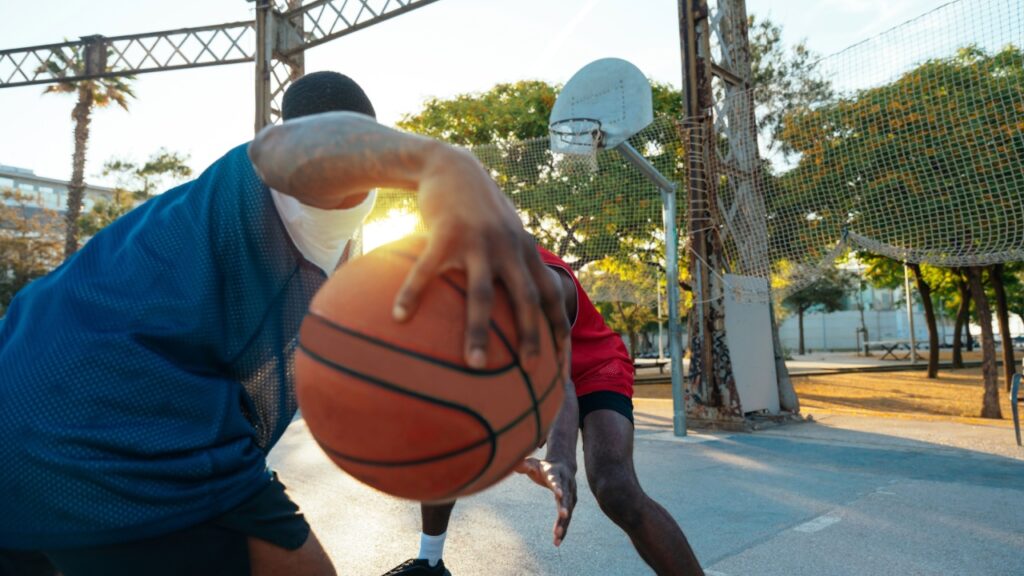
Basketball is evolving.
What used to be a game where players had very fixed roles, like point guard, center, or power forward, is now shifting toward more flexible play. Today, many teams embrace positionless basketball.
Players are not confined to one role or spot on the floor. Instead, they can dribble, pass, shoot, and defend in multiple ways, even if they are traditionally seen as a big man or guard. This approach is reshaping how teams win, how coaches train athletes, and how young players develop their skills.
The Origins of Positionless Basketball
Traditional Positions in Basketball
For decades, basketball revolved around a five-position system: point guard, shooting guard, small forward, power forward, and center. Point guards were the main ball handlers and playmakers. Shooting guards often focused on scoring from the perimeter.
Forwards, both small and power, played versatile roles on the wings or near the basket. Centers were typically the tallest players, anchoring the paint, rebounding, and protecting the rim.
While these roles were more rigid than today, some fluidity always existed, such as point-forwards and stretch forwards, showing early examples of versatility in player roles.

The Shift Begins
Over time, coaches and analysts noticed that limiting players to strict roles could hold back creativity and efficiency. Two main trends pushed the shift:
Three-Point Revolution
Teams began taking and making many more three-point shots, emphasizing floor spacing. Big players started shooting from longer distances, which changed offensive strategies and opened up new opportunities for versatile lineups.
Versatility and Switching Defense
Athletes became more skilled. Players who once had traditional roles began dribbling, passing, and shooting like guards. Defenders now needed to switch often, guarding opponents of very different sizes.
Some coaches describe this philosophy as “permissionless,” meaning players are encouraged to act outside traditional roles and use all their skills freely.
Key Reasons for the Rise of Positionless Basketball
Bigger Players Getting Skillful
Modern centers and forwards can do much more than rebound or score inside. Many can pass, shoot threes, and even orchestrate the offense. Nikola Jokić, for example, regularly leads his team in assists, showing how big men now contribute like playmakers.
Stretch fours, power forwards who can consistently hit three-pointers, are another example. This versatility allows teams to mix speed, size, and skill in new ways, creating challenges for defenses.
Switching and Versatile Defense
Modern basketball defenses often switch on pick-and-rolls. Players must guard a variety of matchups, from quick guards to taller forwards. This has made defensive versatility highly valuable.
Teams no longer rely only on a single big man to protect the rim and a single small player to guard the wings. Instead, switchable lineups allow defenses to adapt quickly.
Redefining Player Roles
The traditional five positions don’t always reflect how players actually play. Analysts have identified multiple role types based on actual skills, such as passing, defending, and rebounding, rather than height or classic position.
This analytical perspective reinforces that positionless basketball is about skill complexity, not just removing labels.
Potential Long-Term Impact of Positionless Basketball
Player Development Changes
Young athletes are being trained differently. Coaches encourage tall players to shoot, pass, and dribble instead of focusing solely on inside scoring. This trend creates future players who are more versatile.
Over time, these skills could reshape scouting, training, and drafting strategies around the world.
Team Building and Strategy
Teams are increasingly building rosters based on skill sets rather than size alone. Coaches can mix and match lineups depending on matchups, choosing faster, switch-friendly players in some situations and more traditional lineups in others. Flexibility in lineups has become a strategic advantage.

Impact on the Business Side
Positionless basketball is changing contracts and awards. Traditional positions are now less important when recognizing player value. All-NBA and All-Defensive teams are now chosen without strict positional slots.
Analytics also play a larger role, with teams tracking versatility, passing, defensive switches, and contributions outside traditional roles.
Risks and Drawbacks
Despite the benefits, positionless basketball has potential downsides:
- Overemphasis on versatility may underuse elite specialists, such as shot-blockers who don’t shoot threes.
- Players taking on multiple roles may face greater physical strain or fatigue.
- Coaches must design more complex systems, which can be difficult to execute consistently.

Frequently Asked Questions
Q: Is positionless basketball new?
Not entirely. Hybrid roles like point-forwards and stretch bigs have existed for decades, but the trend has accelerated in recent years due to analytics, coaching strategies, and the three-point revolution.
Q: Who popularized it?
There’s no single inventor. Teams like the Golden State Warriors and coaches like Erik Spoelstra are often cited for modern examples, though earlier trends like “small ball” and point-forward roles contributed to their rise.
Q: Doesn’t it weaken big men’s importance?
Not necessarily. Big men are still vital, but their roles are evolving. Many now pass, shoot from distance, and defend smaller players, adding versatility without removing their value.
Q: Will the NBA return to strict positions?
It seems unlikely soon. With positionless All-NBA teams and the emphasis on versatile play, the league has embraced flexible roles, though future strategies could adjust slightly.
Q: Are there critics?
Yes. Some argue the concept is overhyped, pointing out that players still often fit certain positional tendencies. Others worry that key specialists might be underutilized or that flexible systems could complicate coaching.
Conclusion
- Positionless basketball emphasizes versatility, skill, and flexibility over rigid roles.
- Big men pass and shoot, guards defend multiple positions, and everyone contributes in new ways.
- Player development is evolving, producing athletes trained in multiple skills rather than one position.
- Teams now build rosters and lineups based on adaptability and matchups.
- Awards and recognition are changing to reflect versatility rather than traditional positions.
- Despite risks like loss of specialists, physical strain, and strategic complexity, positionless basketball is shaping the future of the sport, creating smarter, more dynamic, and creative play.
Read More:
- How Minor League Life Shapes MLB Stars
- The Unsung Heroes Behind Championship Bullpens in MLB
- MLB’s Greatest Moments Fans Never Forget
This article was made with AI assistance and human editing.



